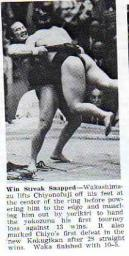
When I went to Japan in the early 1980s, I expected to love many things: the simplicity of the architecture and the art, the gardens, the calligraphy, the pottery, the flower arranging. But it came as a shock to me when I became a passionate sumo fan.
I’m not a sports enthusiast. I dreaded PE at school. I couldn’t catch, throw, run or hit. I went to high school football games to be with friends and because I liked our marching band, not because I understood or enjoyed the game.
The day my friend turned on the sumo tournament, I stayed to watch, determined to experience as much as I could of Japanese culture. Within a few minutes, I was hooked. I waited impatiently for the broadcasts of each of the six annual two-week tournaments and rushed home every day to catch the last hour or so. I learned the wrestlers’ names. I had favorites (Wakashimazu and Chiyonofuji). I groaned when they lost. My Japanese friend thought my addiction was hilarious.
When you stop laughing (everyone does), you may gasp, “Why?” What is so fascinating about two men, naked except for a loincloth and usually weighing 200 to 300 pounds (occasionally way more), grappling together in a small ring?
Simplicity, for one. The first man who is forced out of the ring, or who touches the ground with anything but the soles of his feet, loses. No “downs,” no foul balls, no changing goal loyalties, no time out. This is a sport I can understand.
Second, brevity. The actual physical engagement may take only seconds. Long contests may last several minutes. During that time, amazing upsets can happen. Then it’s done. Move on.
Third, the ritual. The ritual run-up to the point where the wrestlers engage is much longer than the actual fight. This is one of the things I love the most about sumo, and many non-Japanese hate. What fascinates me is the way the wrestlers use this time to settle themselves, draw in their energy. They hurl salt into the ring (a symbol of purification), step in, move to the center, squat and confront each other for a moment, rise and return to their corners. They repeat this a number of times. There is no religious, historical, philosophical parallel in football, baseball, or basketball (the huddle doesn’t come close). The nearest thing I can think of is the quiet preparation and measuring of the green that some golfers make.
Fourth, the psychological game. After the salt is thrown into the ring, the wrestlers squat and face off and stare at each other, almost literally nose to nose. You can practically hear them thinking to each other: Dude! Give it up now. You won’t win this one. They are trying to psych each other out, and probably psych themselves up. They are seriously taking the measure of their opponent.
Think about it. No uniforms, no weapons. Just two naked guys sizing each other up. Talk about the need for self-confidence.
One thing that is intriguing about this ritual confrontation is that it takes place within a set amount of time. Eventually the ref will call time and the wrestlers engage. But the rules say that if the wrestlers mutually agree, they can engage before the time period is up. I saw this happen twice. Somehow, telepathically, the two wrestlers signal each other that it’s time. No words spoken. No consultation. No hand signals. They’re just ready to engage. They both know it. And they do it. How cool is that?
Lastly, sumo has a certain dignity about it. No histrionics, no arm pumping, no bad boy/girl tantrums. No mouth. One wrestler falls or is moved out of the ring. The winner often extends a hand to help the loser stand. They retire to their corners. They bow to each other. They leave the arena with quiet dignity as if thousands of fans weren’t even there. Now that’s classy.
Since coming home, I’ve only seen sumo on television once. But as broadcast by ESPN, all the ritual has been cut away. Only the momentary action is shown. No wonder few non-Japanese care for sumo. They don’t know the whole story.
So don’t laugh at the sumo wrestler bobble-head dolls on the dashboard of my car. Bow respectfully to the passionate sumo addict. I have large friends.

No Comments